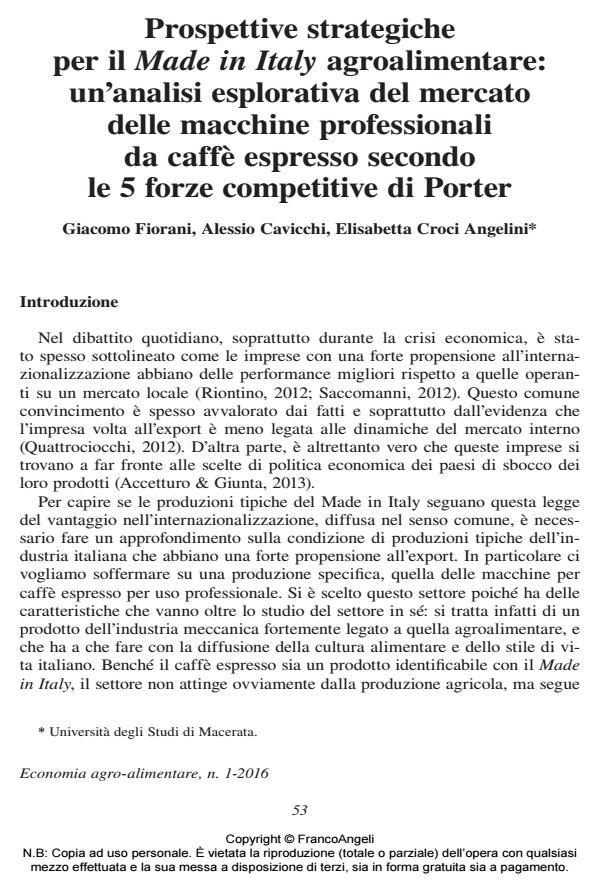Strategic perspectives on "Made in Italy": an exploratory market analysis of professional espresso coffee machines according to Porter’s five competitive forces
Journal title ECONOMIA AGRO-ALIMENTARE
Author/s Giacomo Fiorani, Alessio Cavicchi, Elisabetta Croci Angelini
Publishing Year 2016 Issue 2016/1
Language Italian Pages 19 P. 53-71 File size 160 KB
DOI 10.3280/ECAG2016-001004
DOI is like a bar code for intellectual property: to have more infomation
click here
Below, you can see the article first page
If you want to buy this article in PDF format, you can do it, following the instructions to buy download credits

FrancoAngeli is member of Publishers International Linking Association, Inc (PILA), a not-for-profit association which run the CrossRef service enabling links to and from online scholarly content.
It is well known that the agri-food industry represents an important leverage for Italian exports. Espresso coffee is one of the drivers of this industry and is one of the key Made in Italy assets. Exporting espresso means spreading Italian culture. In fact, Espresso is widely associated with the Italian way of life, even though agricultural coffee production takes place very far from Italy. The connection between espresso and Italy is not provided only by the consumption culture, but also by the production of machinery for espresso preparation. Italian firms are an example of excellence in the production of traditional espresso machines. The development of the international horeca (hotel-restaurant-café) sector provides an opportunity for both the espresso producers and the connected industrial sectors, to improve their position in the international markets. This article presents an analysis of the coffee machine sector, with particular regard to its connections with the horeca sector. Porter’s framework of five forces is used to show the competitive environment in which the interested sectors operate. A snapshot of the relationships within the espresso coffee sector is taken using analysis of a variety of sources. The focus is on professional coffee machines and the possible development of this industry. Through a collection of secondary data, this article highlights the challenges faced by the espresso coffee machines manufacturers. On one hand it demonstrates that it is possible to spread Italian culture through coffee consumption. On the other hand, new global challenges are emerging, such as the growing coffee capsule market.
Keywords: Espresso, coffee, five forces, coffee machines, horeca
Jel codes: Q13, L66, M31
- Accetturo, A., D’Ignazio, A., Franceschi, F., & Giunta, A. (2012). Global Value Chains and the Great Recession: Evidence from Italian and German Firms. Mimeo.
- Creazza, A. (2012). Servire il Caffè in Capsule. Logistica, Centro di Ricerca sulla Logistica - Università Cattaneo liuc, pp. 46-49.
- Della Santa, L. (2012). If You Think That the Future of Coffee Machines is All Pods, Think Again. Analyst Insight by Lorenza Della Santa, Senior Analyst – Consumer Appliances at Euromonitor International.
- Giuli, M. & Pascucci, F. (2014). Il ritorno alla competitività dell’espresso italiano. Situazione attuale e prospettive future per le imprese della torrefazione di caffè. Milano: FrancoAngeli.
- Harford, T. (2006). L’Economista Mascherato. Milano: Rizzoli.
- Indiatsy, C.M., Mwangi, M.S., Mandere, E.N., Bichanga, J.M. & George, G.E. (2014). The Application of Porter’s Five Forces Model on Organization Performance: A Case of Cooperative Bank of Kenya Ltd. European Journal of Business and Management, 6(16), 75-85.
- Jolliffe, L. (Ed.) (2010). Coffee culture, destinations and tourism (Vol. 24). Channel View Publications.
- Marketline (gennaio 2012). Global Profit Foodservice.
- Marketline (maggio 2012). Global Fast Food.
- Marketline (novembre 2013 [2]). Global Hotels, Restaurants & Leisure.
- Marketline (novembre 2013). Global Hot Drinks.
- Mathison, S. (1988). Why triangulate? Educational researcher, 17(2), 13-17. DOI: 10.3102/0013189x017002013
- Morris, J. (2005). Imprenditoria italiana in Gran Bretagna Il consumo del caffè “stile italiano”. Italia Contemporanea, 241, 540-552.
- Morris, J. (2006). La globalizzazione dell’espresso italiano. Memoria e ricerca, 23, 27-46.
- Morris, J. (2010). Making Italian espresso, making espresso Italian. Food and History, 8(2), 155-183.
- O’Brien, W.J., London, K., & Vrijhoef, R. (2004). Construction supply chain modeling: a research review and interdisciplinary research agenda. ICFAI journal of operations management, 3(3), 64-84.
- Pascucci, F. (2009). La politica distributiva nei mercati esteri tra canali offline e online: il caso della Nuova Simonelli. Micro & Macro Marketing, 18(3), 505-534.
- Perdana, A., Roshetko, J.M., & Kurniawan, I. (2012). Forces of competition: smallholding teak producers in Indonesia. Int. Forest. Rev., 14(2), 238-248. DOI: 10.1505/146554812800923417
- Ponte, S. (2002). Thelatte revolution’? Regulation, markets and consumption in the global coffee chain. World development, 30(7), 1099-1122.
- Porter, M.E. (1979). How competitive forces shape strategy.
- Porter, M.E. (2008). The five competitive forces that shape strategy. Harvard business review, 86(1), 25-40.
- Quattrociocchi, B. (2012). La propensione all’internazionalizzazione delle reti italiane: luci e ombre. Sinergie rapporti di ricerca.
- Rauscher, I. & Andriani, P. (2009). Illycaffè and the Brazilian espresso knowledge network. In Dynamic Learning Networks (pp. 57-73). Springer US.
- Riontino, C. (2012). Mappatura e performance delle aree italiane ad alta specializzazione agro-alimentare. Agriregionieuropa, 8(29).
- Saccomani, F. (2012). L’internazionalizzazione delle imprese: fattore di crescita e competitività. Presentazione del rapporto “L’economia del Veneto” [The internationalization of enterprises: A factor of growth and competitiveness. Presentation of the report “The economy of the Veneto”]. Bank of Italy, Venice, Italy.
- Scupola, A. (2002). The impact of electronic commerce on industry structure - the case of scientific, technical and medical publishing. Journal of Information Science, 28(4), 275-284. DOI: 10.1177/016555150202800402
- Senauer, B. & Seltzer, J. (2010). The changing face of food retailing. Choices, 25(4).
- Talbot, J.M. (1995). Regulating the coffee commodity chain: Internationalization and the coffee cartel. Berkeley journal of sociology, 40, 113-149
Giacomo Fiorani, Alessio Cavicchi, Elisabetta Croci Angelini, Prospettive strategiche per il Made in Italy agroalimentare: un’analisi esplorativa del mercato delle macchine professionali da caffè espresso secondo le 5 forze competitive di Porter in "ECONOMIA AGRO-ALIMENTARE" 1/2016, pp 53-71, DOI: 10.3280/ECAG2016-001004